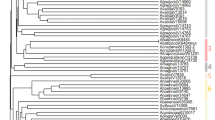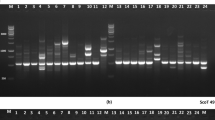Abstract
The genetic relationships and diversity within the European and Asiatic Buxus species were analysed using AFLP, genome size analysis and chromosome counts. Based on these results two major clusters could be defined. One genetic cluster contained B. sempervirens and B. balearica, European species, and B. colchica, an Asiatic species but with leaf morphology similar to B. sempervirens. Species in this cluster were characterised by a genome size between 1.38 and 1.69 pg 2C−1 and a chromosome number of 2n = 2x = 28 (diploid). Only four B. sempervirens cultivars within this cluster were triploid. A second cluster contained the Asiatic Buxus species B. microphylla, B. harlandii, B. hyrcana, B. myrica, B. henryi, B. bodinieri and B. wallichiana. Within this second genetic cluster three different ploidy levels could be observed. B. harlandii, B. hyrcana and nine B. microphylla cultivars were tetraploid (2n = 4x = 56) with a genome size of >2.5 pg 2C−1. Fifteen other B. microphylla cultivars were triploid (2n = 3x = 42). The other Asiatic Buxus species, B. henryi, B. bodinieri and eight B. microphylla cultivars, were diploid with a genome size of ca. 1.5 pg 2C−1.



Similar content being viewed by others
References
Barakat A, Carels N, Bernardi G (1997) The distribution of genes in the genomes of Gramineae. Proc Nat Acad Sci USA 94:6857–6861
Bennett MD, Leitch IJ (2005) Nuclear DNA amounts in angiosperms: progress, problems and prospects. Ann Bot 95:45–90
Carlquist S (1982) Wood anatomy of Buxaceae: correlations with ecology and phylogeny. Flora 172:463–491
Cerbah M, Mortreau E, Brown S, Siljak-Yakovlev S, Bertrand H, Lambert C (2001) Genome size variation and species relationships in the genus Hydrangea. Theor Appl Genet 103:45–51
Darlington CD, Wylie AP (1955) Chromosome atlas of flowering plants, 2nd edn. George Allen & Unwin, London
Dimitrova D, Ebert I, Greilhuber J, Kozhuharov S (1999) Karyotype constancy and genome size variation in Bulgarian Crepis foetida s.l. (Asteraceae). Plant Syst Evol 217:245–257
Dolezel J, Greilhuber J (2010) Nuclear genome size: are we getting closer? Cytometry 77(A):635–642
Dolezel J, Barto J, Voglmayr H, Greilhuber J (2003) Nuclear DNA content and genome size of trout and human. Cytometry 51(A):127–128
Doyle J, Doyle JL (1987) Genomic plant DNA preparation from fresh tissue: CTAB method. Phytochem Bull 19:11
Gentry AH, Aymard G (1993) A new species of Styloceras (Buxaceae) from Peru. Novon 3:142–144
Greilhuber J, Dolezel J, Lysak MA, Bennett MD (2005) The origin, evolution and proposed stabilization of the terms ‘genome size’ and ‘C-value’ to describe nuclear DNA contents. Ann Bot 95:255–260
Greilhuber J, Temsch EM, Loureiro JCM (2007) Nuclear DNA content measurement. In: Dolezel J, Greilhuber J, Suda J (eds) Flow cytometry with plant cells: analysis of genes chromosomes and genomes. Wiley-VCH, Weinheim, pp 67–101
Hanson L, Brown RL, Boyd A, Johnson MAT, Bennett MD (2003) First nuclear DNA C-values for 28 angiosperm genera. Ann Bot 91:1–8
Hawkins JS, Hu G, Rapp RA, Grafenberg JL, Wendel JF (2008) Phylogenetic determination of the pace of transposable element proliferation in plants: copia and LINE-like elements in Gossypium. Genome 51:11–18
Hutchinson J (1967) The genera of flowering plants (Angiospermae), vol 2. Clarendon Press, Oxford
Jarvis CE (1989) A review of the family Buxaceae Dumortier. In: Crane PR, Blackmore S (eds) Evolution, systematics, and fossil history of the Hamamelidae, vol I. Science Publications, Oxford, pp 273–278
Jeschke MR, Tranel PJ, Rayburn AL (2003) DNA content analysis of smooth pigweed (Amaranthus hybridus) and tall waterhemp (A. tuberculatus): implications for hybrid detection. Weed Sci 51:1–3
Johnston MTJ, Husband BC, Burton TL (2003) Habitat differentiation between diploid and tetraploid Galax urceolata. Int J Plant Sci 164:703–710
Karrenberg S, Widmer A (2008) Ecologically relevant genetic variation from a non-Arabidopsis perspective. Curr Opin Plant Biol 11:156–162
Knight CA, Molinari NA, Petrov DA (2005) The large genome constraint hypothesis: evolution, ecology and phenotype. Ann Bot 95:177–190
Köhler E (1981) Pollen morphology of the West Indian-Central American species of the genus Buxus L. (Buxaceae) with reference to taxonomy. Pollen Spores 23:38–91
Köhler E (1984) Zur Blattnervatur der neotropischen Buxus-Arten und ihre Bedeutung für die Systematik (Buxaceae). Flora 175:345–374
Köhler E (1990) Zur Blattnervatur der afrikanischen Buxus- und Notobuxus-Arten. Feddes Repertorium 101:243–255
Köhler E (1994) Parallel evolution of pollen characters in the genus Buxus L. (Buxaceae). Acta Bot Gallica 141:223–232
Köhler E, Brückner P (1982) Die Pollenmorphologie der afrikanischen Buxus- und Notobuxus-Arten (Buxaceae) und ihre systematische Bedeutung. Grana 21:71–82
Köhler E, Brückner P (1983) Zur Pollenmorphologie und systematischen Stellung der Gattung Simmondsia Nutt. Wiss Z Jena 32:945–955
Köhler E, Brückner P (1989) The genus Buxus (Buxaceae): aspects of its differentiation in space and time. Plant Syst Evol 162:267–283
Köhler E, Brückner P (1990) Considerations on the evolution and chorogenesis of the genus Buxus (Buxaceae). Mem NY Bot Gard 55:153–168
Köhler E, Schirarend C (1989) Zur Blattanatomie der neotropischen Buxus-Arten und ihre Bedeutung für die Systematik (Buxaceae). Flora 183:1–38
Kubatova B, Travnicek P, Bastlova D, Curn V, Suda J (2008) DNA ploidy level variation in native and invasive populations of Lythrum salicaria at a large geographical scale. J Biogeogr 35:167–176
Lafuma L, Balkwill K, Imbert E, Verlaque R, Maurice S (2003) Ploidy level and origin of the European invasive weed Senecio inaequidens (Asteraceae). Plant Systematics Evolution 243:59–72
Larson PD (1999) Boxwood: its history, cultivation, propagation and descriptions. Foliar Press, Virginia
Lysak MA, Dolezelova M, Horry JP, Swennen R, Dolezel J (1999) Flow cytometric analysis of nuclear DNA content in Musa. Theor Appl Genet 98:1344–1350
Mahelka V, Suda J, Jarolimova V, Travnicek P, Krahulec F (2005) Genome size discriminates between closely related taxa Elytrigia repens and E. intermedia (Poaceae: Triticeae) and their hybrid. Folia Geobot 40:367–384
Murray BG, De Lange PJ, Ferguson AR (2005) Nuclear DNA variation, chromosome numbers and polyploidy in the endemic and indigenous grass flora of New Zealand. Ann Bot 96:1293–1305
Nei M, Li WH (1979) Mathematical model for studying genetic variation in terms of restriction endonucleases. Proc Nat Acad Sci USA 76:5269–5273
Olivier D (1882) Notobuxus natalensis Oliv. In: Hooker JD (ed) Icones plantarum 14, table 1400. London
Phillips ED (1943) Some changes in nomenclature IV. J S Afr Bot 9:137–140
Pijnacker LP, Ferwerda MA (1984) Giemsa C-banding of potato chromosomes. Can J Genet Cytol 26:415–419
Reeves A (2001) Micromeasure: a new computer program for the collection and analysis of cytogenetic data. Genome 44:439–443
Suda J, Malcova R, Abazid D, Banas M, Prochazka F, Sida O, Stech M (2004) Cytotype distribution in Empetrum (Ericaceae) at various spatial scales in the Czech Republic. Folia Geobot 39:161–171
Suda J, Kron P, Husband BC, Travnicek P (2007) Flow cytometry and ploidy: applications in plant systematics, ecology and evolutionary biology. In: Dolezel J, Greilhuber J, Suda J (eds) Flow cytometry with plant cells: analysis of genes chromosomes and genomes. Wiley-VCH, Weinheim, pp 103–130
Van De Peer Y, De Wachter R (1994) TREECON for windows: a software package for the construction and drawing of evolutionary trees for the Microsoft Windows environment. Comput Appl Biosci 10:569–570
Van Laere K, Leus L, Van Huylenbroeck J, Van Bockstaele E (2009) Interspecific hybridisation and genome size analysis in Buddleja. Euphytica 166:445–456
Van Trier H, Hermans D (2005) Buxus. Stichting Kunstboek, Oostkamp
von Balthazar M, Endress PK (2002a) Development of inflorescences and flowers in Buxaceae and the problem of perianth interpretation. Int J Plant Sci 163(6):847–876
von Balthazar M, Endress PK (2002b) Reproductive structures and systematics of Buxaceae. Bot J Linn Soc 140:193–228
von Balthazar M, Endress PK, Qiu YL (2000) Phylogenetic relationships in Buxaceae based on nuclear internal transcribed spacers and plastid ndhF sequences. Int J Plant Sci 161:785–792
Wicker T, Keller B (2007) Genome-wide comparative analysis of copia retrotransposons in Triticeae, rice and Arabidopsis reveals conserved ancient evolutionary lineages and distinct dynamics of individual copia families. Genome Res 17:1072–1081
Zonneveld BJM (2001) Nuclear DNA contents of all species of Helleborus (Ranunculaceae) discriminate between species and sectional divisions. Plant Syst Evol 229:125–130
Author information
Authors and Affiliations
Corresponding author
Rights and permissions
About this article
Cite this article
Van Laere, K., Hermans, D., Leus, L. et al. Genetic relationships in European and Asiatic Buxus species based on AFLP markers, genome sizes and chromosome numbers. Plant Syst Evol 293, 1–11 (2011). https://doi.org/10.1007/s00606-011-0422-6
Received:
Accepted:
Published:
Issue Date:
DOI: https://doi.org/10.1007/s00606-011-0422-6




